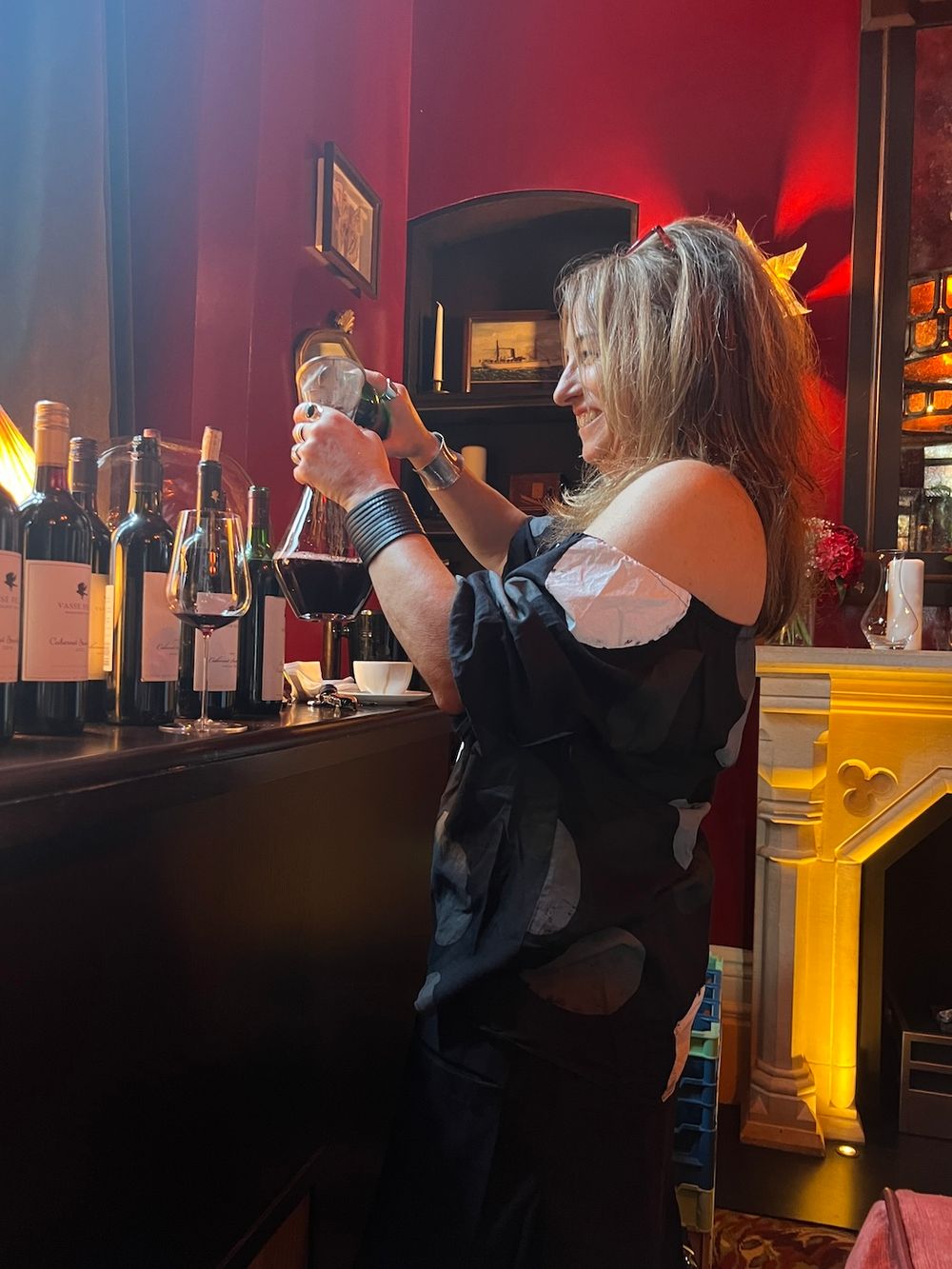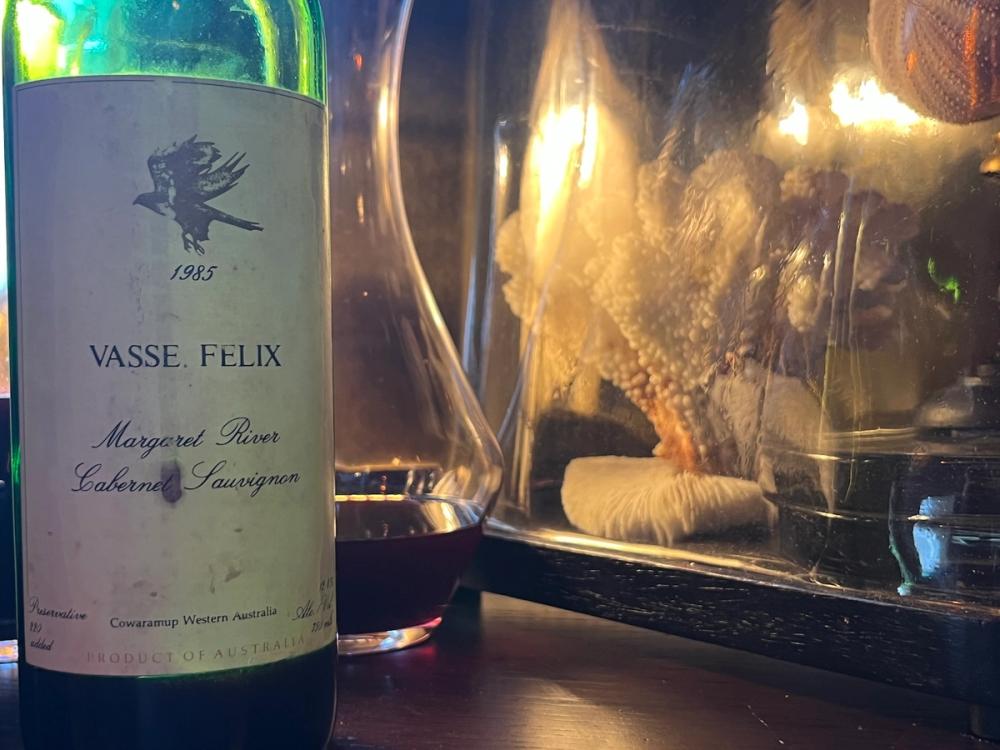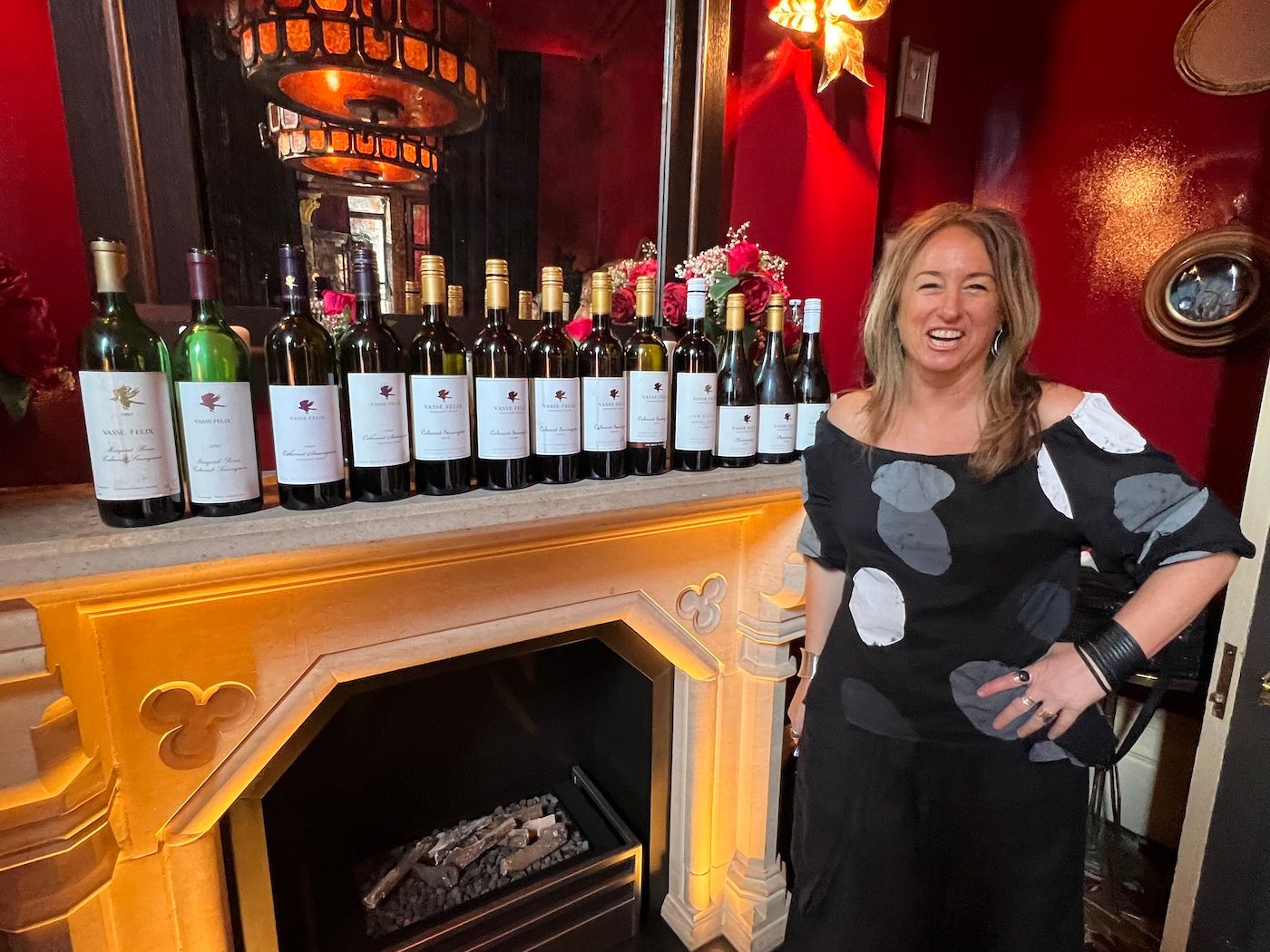“There are two types of people in this world – olive eaters and lolly eaters,” Virginia Willcock proclaims, “and we are olive eaters.”

50 years of Vasse Felix and Margaret River Cabernet Sauvignon lunch, London, September 19, 2024
Vasse Felix’s chief winemaker for the past 18 years is holding court in the blood red private dining room of London’s St Pancras Renaissance Hotel to celebrate 50 years of Vasse Felix and Margaret River Cabernet Sauvignon. In order to do this she’s brought along nine vintages of the estate’s premium Cabernet Sauvignon and plenty of anecdotes in order to illustrate how the perfume, acidity and tannins of Margaret River Cabs combine as an exemplary manifestation of the variety.
“I’ve got a savoury tooth and Vasse Felix is a savoury wine house. I find these tobacco, woodsy characters in the wine, dried crunchy Aussie forest floor, tea tree and ‘peppi’ tree* and I find that endearing. To me it smells like home, it’s distinct, unique and that’s important.”

Rock 'n' roll winemaker: Virginia Willcock
Willcock is like your best mate’s sister – vivacious, a little bit rock n roll, a ring on each thumb as well as every finger and an endearing sense of mischief, you could imagine her wigging out in a mosh pit just as easily as savouring library vintages in an old hotel, such as this one.
As per winemaking style, she’s always liked to put that little bit of funk into her Chardonnay but, contrastingly, her style of Cabernet Sauvignon is all about elegance and restraint.
“People think that Cabernet Sauvignon has a ‘gap’ but that’s the biggest load of bollocks! There is no ‘hole’… it is elegant and succulent, it is about shape and form… I can’t stand the thought of ‘filling the gap’.”
Willcock is alluding to how the Bordelais taught the world to ‘fill the gap’ with Merlot, but also to earlier vintages of Vasse Felix Cab Sav that had a percentage of Shiraz in them.
“The 1995 Vasse Felix Cabernet Sauvignon was a Clive Owen wine (the estate’s second winemaker) and in the late 1980s everyone started picking riper – it was the beginning of what I call the ‘era of scientific winemaking in Australia’, people were trying to make wines bigger with a lot of knowledge coming out of Barossa. Clive liked a little bit of Shiraz in his Cab but I don’t like it. It’s handy at making wines bigger and richer but I think it shows a lack of confidence when you try and fill your palate.”
Willcock is blessed with growing Cab in the soils and climate of Margaret River, but she’s defiant that the variety has much more subtlety than it’s given credit for.
“I believe you need to see what the variety offers – I think in the 2000s people started understanding Cabernet Sauvignon better and giving it a lighter framework and shape, I have always been against the addition of tannins and Shiraz. With Margaret River, there’s no other Cabernet like it in the world, people think of it as a black and muscly grape but we’re more into an old Bordeaux style – and you could even say Bordeaux is copying Margaret River now.”
Blast from the past

Open for business: Tom Cullity and Jack Mann (r-l)
Willcock believes Margaret River sees its own identity as unique and very different to Bordeaux but that wasn’t always the case – the wine pioneers here in the late 1960s were encouraged to see themselves as the ‘new Bordelais’. Vasse Felix was established in 1967 by Tom Cullity who planted mainly Cabernet Sauvignon and Malbec because they were the only two Bordeaux varieties available in Western Australia when Dr John Gladstones had famously stated a year earlier that Margaret River was the closest winemaking region to Bordeaux.
“John Gladstones said we were the closest region to Bordeaux but we now see ourselves very different to Bordeaux – it has, however, given us an historical and unique position in the world of winemaking,” Willcock says.

Tom Cullity plants the first vines in Margaret River
The vines Cullity planted were cuttings from the WA Department of Agriculture cool store, a selection from the Swan Valley by legendary winemaker Jack Mann; now known as the Houghton Clones these are unique to Western Australia and arrived in the country sometime in the 1800s meaning that the Vasse Felix estate is tapped into arguably the oldest mass selection Cab Sav vines grown on their own rootstock in the world.
Of course, Margaret River today is a far cry from those early pioneer days. According to Willcock the truffle season (!) has just ended where “you can get a bowl of chips with freshly grated black truffle on and a pint of Guinness down the pub.”
When Tom Cullity founded Vasse Felix he would have been lucky to find a pub, let alone a bowl of truffled chips, anywhere on the 5-hour drive between Margaret River and Perth where he worked as a cardiologist. Driving an old Peugeot on largely dirt roads to prune vines on a weekend, Willcock describes it simply as “insanity”.
After planting vines in 1967 Cullity’s first vintage was 1971 but the entire crop was lost to bunch-rot and silver-eyes, a local species of bird.
Over the next year Cullity had a peregrine falcon trained to solve the problem but, just when it was called into action the following year, the bird of prey was released and promptly flew away never to be seen again. It’s respect to Cullity then that the bird is pictured on every bottle of Vasse Felix wine “as a protector of the wine of the future,” Willcock smiles.
Silver-eyes have always been a pressure at harvest which is why wines from the 1970s here were ‘tighter and greener’ because winemakers picked the grapes before the birds could get to them; the increased ripeness of Margaret River wines in the 1980s can therefore be attributed to the introduction of bird nets which allowed winemakers to pick the fruit later without fear of losing their crop.
Other hurdles in Margaret River during the 1970s included the lack of available equipment.
“People were making wine here quite naturally, there was no industrialisation, no additives,” Willcock says, “Tom got a barrel made by his brother Gary which was cleaned by ‘peppi’ tree* branches. It was all quite rudimentary and rustic.”

David Gregg through the years
It took David Gregg, an English cheesemaker who was appointed Vasse Felix’s first winemaker in 1973, two years before he bought his first cultured yeast over from the East Coast. In the same year he discovered malolactic fermentation by accident when, in order to obtain a barrel for ageing their wine in, he and Cullity bought a barrel full of Château Figeac, siphoned the wine off and then used the barrel for ageing the Vasse Felix Cabernet in.
“They didn’t think there was such a thing as secondary fermentation but it happened naturally from that day forward,” Willcock says.
Another yarn that Willcock shared was when Tom Cullity invited his neighbours round to drink his first vintage of Riesling. “These people had never drunk wine before,” Willcock explains, “so they were drinking it like it was beer. They were all over the place and nobody made it home that night.”
The first Riesling (or what was left of it) also created a stir at the Perth Wine Show where it won a Gold Medal and alerted the Australian public to the potential of winemaking here. The following year the second Cabernet Sauvignon, the 1973, also won gold. Of course, the estate and its wines have a trophy cabinet as full as Man City’s but it was still generous of Willcock to bring along a 1985 Cab Sav to the lunch, the oldest vintage we tasted in the line-up.
CEO and winery owner Paul Holmes à Court, (whose father Robert, Australia’s first billionaire, bought Vasse Felix in 1987 after Gregg ran into financial difficulties) describes the 1985 as a wine that has a special connection for him.
“One of the most memorable vintages for me was the 1985 Cabernet Sauvignon. I remember clearly because there's a great back story to it. After entering the wine in the World Trade Fair in London in early 1987, David Gregg was approached by Woodside Petroleum with an offer to purchase the entire vintage for use as corporate gifts. Short of cash, David thought it was a great deal, so he took it.”
“Famously, the wine went on to win the trophy for Best Red Wine at the Fair, but there was no wine left to sell! After my father purchased Vasse Felix later that year, we discovered that David had earlier shipped a small parcel of the wine to the UK. We went into the secondary market and bought back as much as we could. We have some of those bottles in the cellar still.”
Apart from one that is ;)
Tasting nine vintages of Vasse Felix Cabernet Sauvignon

The wines we tasted at this anniversary lunch covered three winemakers, David Gregg, Clive Otto and Virginia Willcock, and gave us a snapshot of five decades. There were so many variables it was hard to draw any conclusions except that the wines varied enormously by vintage – this is no cookie-cutter cuvée – and, in the last two vintages at least the percentage of Cabernet Sauvignon is tracking at 85/6% with Malbec making up most of the shortfall (Cab Franc, Merlot, Petit Verdot and Shiraz all making an appearance through the vintages).
Malbec, along with Cab Sauv, was one of the two original varieties planted here. Having visited Laura Cantena in Argentina, Willcock believes they have exactly the same clone. Vasse Felix moved away from using Malbec so much but it now constitutes 13/4 % of the blend with the estate’s top wine Tom Cullity described on the label as a Cabernet/ Malbec blend.
“My first vintage of Malbec blew my mind – I had goosebumps. I’ve (subsequently) done lots of experiments with Malbec, it has a lovely mulberry flavour, rich and dense much like Cahors, fleshy and meaty like and, when it’s mixed with Cab it’s just just magical, the estate style.”
During the tasting, the younger vintages – 2018-2021 showed the Malbec more but after 10 years or so it lends a beautiful suppleness to the wine.

There are a lot of aged Bordeauxs that would be happy to be as good as Vasse Felix Cabernet Sauvignon 1985, browny red with a stunning nose, it had so much going on – sweet, rich aged fruit, dried flowers, mint, blood, ginger nut – the acidity holding it together. Tasted blind the Vasse Felix Cabernet Sauvignon 1995 could have foxed you with its 6% Shiraz, that said it had juicy blackcurrant cloaking gently-rasping tannins. Fresh, focused with an amazing finish. The Vasse Felix Cabernet Sauvignon 2005, Clive Otto’s last vintage, was not in a good place and disjointed. Both bottles had strong mushroom notes, very ripe, jammy fruit, huge concentration. Nah. Willcock’s second vintage Vasse Felix Cabernet Sauvignon 2008 was astonishingly fresh and could easily last another two decades (no Vasse Felix wines after 2006 had cork closure). Considered a bit too tight on release but settled within itself now and fresh as a daisy, this showed the stylistic sea change between the two winemakers, Willcock making a beautifully perfumed and elegant wine with soft but present tannins. The nose had wonderful purity, deep blackcurrant and cassis with a tiny (not unpleasant) hint of Germolene. My tongue was tingly for ages after. Stunning.
After testing smaller fermenters with the 2008 here, with the Vasse Felix Cabernet Sauvignon 2012 Willcock has another level of confidence – trying natural fermentation – and trying to see the transparency of the various blocks. More purply red, more lifted floral aromatics, the palate was bigger, blacker, more intense and structured with micro-fine tannins and mouth-filling juicy fruit. Still very young but it’s the balance that is the standout feature. Clicks together like a beaut.
Flight Two were the four vintages 2018-21 leading up to the 50th vintage (although there seems to be some confusion as to what the 50th vintage is (see ‘Do the Math’ below). Vasse Felix Cabernet Sauvignon 2018 was from a year hailed as ‘the vintage of the century’ although that was what winemakers called it because there were no pressures during growing season. Purply red, open, fresh, bright, lovely tannic structure. Nice register on the palate, elegant, crunchy with a touch of citrus. Vasse Felix Cabernet Sauvignon 2019 was good quality but a vintage blighted by small set numbers in Spring and birds. Bit reserved at first, touch of mint. Good balance but much more structured and concentrated with tannins and acidity dialled up. Vasse Felix Cabernet Sauvignon 2020 waswarmer, plusher, robust with more overt tannins, great balance again, big-fruited with the Malbec bringing more savoury qualities. Willcock says she’s a massive fan of super cool vintages like Vasse Felix Cabernet Sauvignon 2021 so long as you can get the tannins ripe. Bright, vibrant, pure and lifted aromas, forest floor. Crunchy fruit. Great promise.
(*peppermint tree)
The wines of Vasse Felix are imported and sold in the UK through Fells which is a commercial partner of The Buyer. To discover more about them click here.
































